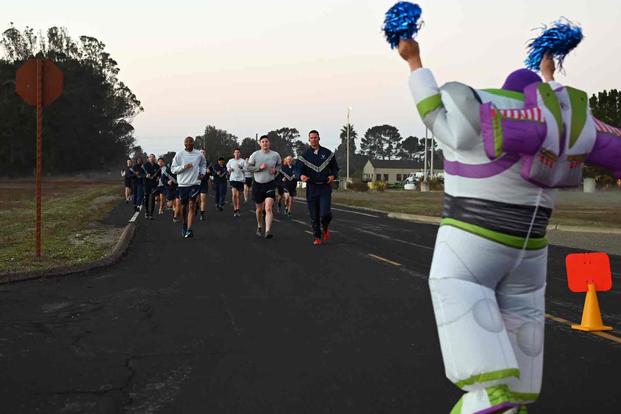A 4 Week Workout Plan for Weight Loss, from a Certified Trainer

My name is Tyler Read. I have a Bachelor of Science in kinesiology, and I’m a National Academy of Sports Medicine certified personal trainer. I’ve been coaching fitness clients for more than a decade.
In that time, the vast majority of my general fitness clients have wanted to lose weight and be healthier — and they typically have not had much time each day for exercise.
With this in mind, I’ve consistently relied on short, hard-hitting workouts my clients can do on a daily basis, alternating cardio and strength training and performing workouts on their own.
Losing weight requires a calorie deficit, meaning you must burn more calories than you eat in a given time frame, typically broken down into calories per day.
Although effective exercise programs can certainly speed up your weight loss, it’s important to remember that long-term weight management requires sustaining healthy habits over time.
This includes eating a variety of whole foods, drinking enough water, and ensuring you get enough sleep and manage stress.
That said, research shows that exercise plays an important role in weight loss (
My 4-week workout plan for weight loss is a great way to kick-start your journey toward better health or add more variety to your workouts if you already consistently exercise.
I build my program around three types of training:
- upper and lower body strength training
- interval training/conditioning
- low intensity cardio
The strength training will help you build muscle and strength that you can apply to your interval training.
Furthermore, the added muscle will increase your metabolism over time, meaning you’ll burn more calories at rest just to sustain yourself, which can contribute to the calorie deficit required for weight loss (
Interval training will provide a massive metabolic boost immediately after your workout. Interval training involves brief periods of high intensity exercise followed by relatively short rest periods.
This method keeps your heart rate elevated throughout the workout, giving you aerobic benefits while maintaining sufficient intensity to stoke your metabolic fire.
Finally, low intensity cardio, such as walking, jogging, swimming, or cycling, gives you a slight bump in your daily calorie burn and allows you to exercise while recovering from the more intense strength and interval training.
You can perform an hour or more of cardio, but even just 20 minutes is sufficient.
Each workout should take roughly 20–22 minutes, allowing you to fit the program into a busy schedule.
Over the course of 4 weeks, this workout structure helps target weight loss on all fronts, through both daily calorie burn and increasing your metabolism over time.
Start with a lighter weight and increase the weight each set until you find the point where the final repetition gets really hard.
Week 1
Day 1: Lower body strength
Equipment: dumbbells or kettlebells, barbell and plates, leg curl and/or leg extension machines
- 3×12 dumbbell/kettlebell goblet squat
- 3×12 barbell or kettlebell deadlift
- 3×20 walking lunge with dumbbells (10 each side)
- Optional: 3×12 leg curl and extension in the gym
Day 2: Low intensity cardio for at least 20 minutes
- Choose walking, light jogging, or your preferred method of cardio — even better if you can do it outside!
Day 3: Upper body strength
Equipment: pullup bar or lat pulldown machine, dumbbells
- 3×12 pullup or lat pulldown
- 3×12 dumbbell overhead press
- 3×12 dumbbell row
- 3×12 dumbbell bench press
- Optional: 3×12 biceps curl and triceps extension
Day 4: Low intensity cardio for at least 20 minutes
Day 5: Interval conditioning
Equipment: plyometric box, slam ball
Perform the following exercises for 15 seconds at a hard pace, then rest for 15 seconds and move to the next exercise. I’ve included two options you can choose between, depending on your current level.
Exercises focus on lower body movements performed at a moderate to high pace.
The large muscle groups in this area help get your heart pumping much more effectively than exercises using smaller muscle groups.
For Week 1, perform 3 rounds of the following as discussed above:
- Squat or jump squat
- Box stepup or power stepup
- Alternating lunge or jumping lunge
- Lateral box stepup or ice skater
- Burpee
Week 2
Week 2 involves the same exercises as Week 1. However, you should be performing 1 warmup set and then switching to the weight you finished with last week and, if possible, increasing the weight each set.
Bump up the intensity or duration of your cardio sessions by 5–10{b574a629d83ad7698d9c0ca2d3a10ad895e8e51aa97c347fc42e9508f0e4325d}. Be sure to keep it light enough that you can perform the minimum 20 minutes without stopping.
For the conditioning, perform 4 total rounds instead of 3.
Day 1: Lower body strength
Equipment: dumbbells or kettlebells, barbell and plates, leg curl/extension machines
- 3×12 dumbbell/kettlebell goblet squat
- 3×12 barbell or kettlebell deadlift
- 3×20 walking lunge with dumbbells (10 each side)
- Optional: 3×12 leg curl and extension
Perform 1 warmup set with body weight or light weight before starting the 3 working sets.
Day 2: Low intensity cardio for at least 20 minutes
- Bump up time or intensity by 5–10{b574a629d83ad7698d9c0ca2d3a10ad895e8e51aa97c347fc42e9508f0e4325d} from Week 1.
Day 3: Upper body strength
Equipment: pullup bar or lat pulldown, dumbbells
- 3×12 pullup or lat pulldown
- 3×12 dumbbell overhead press
- 3×12 dumbbell row
- 3×12 dumbbell bench press
- Optional: 3×12 biceps curl and triceps extension
Perform 1 warmup set with body weight or light weight before starting the 3 working sets.
Day 4: Low intensity cardio for at least 20 minutes
Day 5: Conditioning
Equipment: plyometric box, slam ball
Perform the following exercises for 15 seconds at a hard pace, then rest for 15 seconds and move to the next exercise.
For Week 2, perform 4 rounds of the following as discussed above:
- Squat or jump squat
- Box stepup or power stepup
- Alternating lunge or jumping lunge
- Lateral box stepup or ice skater
- Burpee
Week 3
In Week 3, I reduce the repetitions on the resistance training to 8 per set, which should allow you to increase the weight relative to your 12-rep sets.
If you can, begin performing barbell movements instead of using dumbbells, but either one is OK.
This takes the muscular endurance and movement proficiency from Weeks 1 and 2 and triggers more strength and muscle growth.
Bump up your cardio another 5–10{b574a629d83ad7698d9c0ca2d3a10ad895e8e51aa97c347fc42e9508f0e4325d} and perform 5 total cycles of your interval training.
Day 1: Lower body strength
Equipment: dumbbells or kettlebells, barbell and plates, leg curl/extension machines
- 3×8 barbell back squat or dumbbell/kettlebell goblet squat
- 3×8 barbell or kettlebell deadlift
- 3×16 walking lunge with barbell or dumbbells (8 each side)
- Optional: 3×10 leg curl and leg extension (keep reps higher on these isolation movements)
Perform 1 warmup set with body weight or light weight before starting the 3 working sets.
Day 2: Low intensity cardio for at least 20 minutes
- Bump up time or intensity by 5–10{b574a629d83ad7698d9c0ca2d3a10ad895e8e51aa97c347fc42e9508f0e4325d} from Week 2.
Day 3: Upper body strength
Equipment: pullup bar or lat pulldown, dumbbells
- 3×8 pullup or lat pulldown
- 3×8 barbell or dumbbell overhead press
- 3×8 barbell or dumbbell row
- 3×8 barbell or dumbbell bench press
- Optional: 3×10 biceps curl and triceps extension (keep reps higher on these isolation movements)
Perform 1 warmup set with body weight or light weight before starting the 3 working sets.
Day 4: Low intensity cardio for at least 20 minutes
Day 5: Interval training/conditioning
Equipment: plyometric box, slam ball
Perform the following exercises for 15 seconds at a hard pace, then rest for 15 seconds and move to the next exercise.
For Week 3, perform 5 rounds of the following:
- Squat or jump squat
- Box stepup or power stepup
- Alternating lunge or jumping lunge
- Lateral box stepup or ice skater
- Burpee
Week 4
There is nothing particularly special about Week 4.
You will continue increasing the weight on the strength exercises, bumping up your aerobic intensity, and performing a full 6 rounds of conditioning. If this is too intense, you can dial back as needed.
Day 1: Lower body strength
Equipment: dumbbells or kettlebells, barbell and plates, leg curl/extension machines
- 3×8 barbell back squat or dumbbell/kettlebell goblet squat
- 3×8 barbell or kettlebell deadlift
- 3×16 walking lunge with barbell or dumbbells (8 each side)
- Optional: 3×10 leg curl and extension (keep reps higher on these isolation movements)
Perform 1 warmup set with body weight or light weight before starting the 3 working sets.
Day 2: Low intensity cardio for at least 20 minutes
- Bump up time or intensity by 5–10{b574a629d83ad7698d9c0ca2d3a10ad895e8e51aa97c347fc42e9508f0e4325d} from Week 3.
Day 3: Upper body strength
Equipment: pullup bar or lat pulldown, dumbbells
- 3×8 pullup or lat pulldown
- 3×8 barbell or dumbbell overhead press
- 3×8 barbell or dumbbell rows
- 3×8 barbell or dumbbell bench press
- Optional: 3×10 biceps curl and triceps extension (keep reps higher on these isolation movements)
Perform 1 warmup set with body weight or light weight before starting the 3 working sets.
Day 4: Low intensity cardio for at least 20 minutes
Day 5: Interval training/conditioning
Equipment: plyometric box, slam ball
Perform the following exercises for 15 seconds at a hard pace, then rest for 15 seconds and move to the next exercise.
For Week 4, perform 6 rounds of the following:
- Squat or jump squat
- Box stepup or power stepup
- Alternating lunge or jumping lunge
- Lateral box stepup or ice skater
- Burpee







